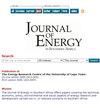Potentials of locally manufactured wound-field flux switching wind generator in South Africa
IF 0.6
4区 工程技术
Q4 ENERGY & FUELS
引用次数: 3
Abstract
The China-based monopoly of high-energy permanent magnet materials used in modern wind generators impact the economic viability and local content value of most wind turbines installed in South Africa, especially large installations. It is possible to design with less expensive excitation technologies using locally-sourced wound-field electromagnets, which might promote local content. This study involves the optimum design performance comparison of the wound-field flux switching machine (WF-FSM) technology based on two variants – Design I and II (D-I and D-II) – the difference being in the arrangement of their DC wound-field coils. The machines are evaluated using finite element analyses (FEA) with optimum performance emphasised on design parameters such as torque density, efficiency and power factor. The selected design targets are meant to improve the performance to cost fidelity of the proposed wind generator variants. In 2D FEA, D-II can produce up to 18.8% higher torque density (kNm/m3) and 17.1% lesser loss per active volume (kW/m3) than D-I. In 3D FEA, the torque density of D-II remains higher at 10.6%, but its loss per active volume increases by 15% compared to D-I. The discrepancy observed in 2D and 3D FEA is due to an underestimation of the end-winding effects in D-II. The power factor of D-II is higher than D-I, both in 2D and 3D FEA, which may translate to lower kVA ratings and inverter costs. A higher total active mass ensues for the studied WF-FSMs than a conventional direct-drive PMSG, but avoiding rare earth PMs translate to significantly lower costs.南非当地制造的伤场磁通开关风力发电机的电势
中国对现代风力发电机中使用的高能永磁材料的垄断影响了在南非安装的大多数风力涡轮机的经济可行性和本地含量价值,特别是大型装置。使用当地的伤口场电磁铁设计更便宜的激励技术是可能的,这可能会促进当地的内容。本研究涉及基于设计I和设计II (D-I和D-II)的两种不同的绕组场开关机(WF-FSM)技术的最佳设计性能比较,其差异在于它们的直流绕组场线圈的排列方式。这些机器使用有限元分析(FEA)进行评估,并在设计参数(如扭矩密度、效率和功率因数)上强调最佳性能。所选择的设计目标是为了提高所提出的风力发电机变体的性能和成本保真度。在2D有限元分析中,D-II的扭矩密度(kNm/m3)比D-I高18.8%,每活跃体积损失(kW/m3)比D-I低17.1%。在三维有限元分析中,D-II的扭矩密度仍然较高,为10.6%,但与D-I相比,其每活跃体积的损失增加了15%。在二维和三维有限元分析中观察到的差异是由于D-II中末端缠绕效应的低估。在2D和3D有限元分析中,D-II的功率因数都高于D-I,这可能转化为更低的kVA额定值和逆变器成本。所研究的WF-FSMs比传统的直接驱动PMSG具有更高的总活性质量,但避免使用稀土pm可以显著降低成本。
本文章由计算机程序翻译,如有差异,请以英文原文为准。
求助全文
约1分钟内获得全文
求助全文
来源期刊

Journal of Energy in Southern Africa
ENERGY & FUELS-
CiteScore
3.00
自引率
0.00%
发文量
16
审稿时长
6 months
期刊介绍:
The journal has a regional focus on southern Africa. Manuscripts that are accepted for consideration to publish in the journal must address energy issues in southern Africa or have a clear component relevant to southern Africa, including research that was set-up or designed in the region. The southern African region is considered to be constituted by the following fifteen (15) countries: Angola, Botswana, Democratic Republic of Congo, Lesotho, Malawi, Madagascar, Mauritius, Mozambique, Namibia, Seychelles, South Africa, Swaziland, Tanzania, Zambia and Zimbabwe.
Within this broad field of energy research, topics of particular interest include energy efficiency, modelling, renewable energy, poverty, sustainable development, climate change mitigation, energy security, energy policy, energy governance, markets, technology and innovation.
 求助内容:
求助内容: 应助结果提醒方式:
应助结果提醒方式:


